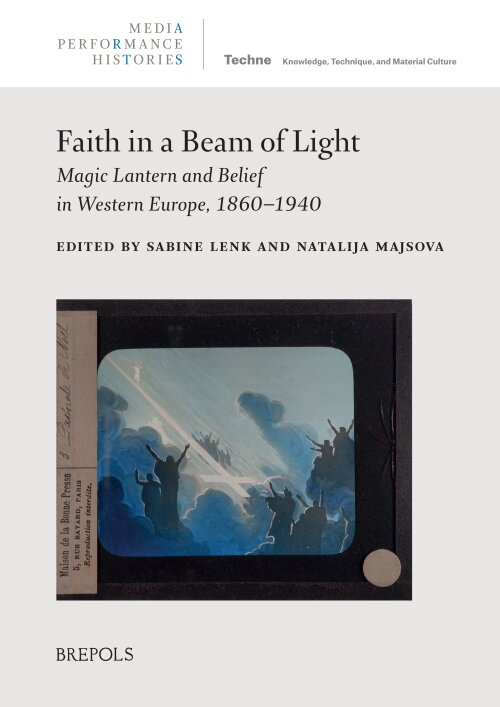Edited by Sabine Lenk & Natalija Majsova
291 p., 34 b/w ills, 37 col. ills, 5 tables b/w., 178 x 254 mm, HB,
Language(s):English, German, French
ISBN 978-2-503-59908-3, € 75 (excl. VAT)
Scheduled for July 2022 - Also forthcoming in Open Access on brepols.net (ISBN 978-2-503-59909-0)

An early visual mass medium, the magic lantern was omnipresent in most Western societies between 1880 and 1930. The Christian Church, especially the Catholics, spiritual associations such as the Freemasons, political interest groups and teaching institutions all made use of lectures enriched by projected images to disseminate information, convictions and doctrines. Moreover, the lantern often featured as a concealed aid in stage spectacles. Nineteen authors analyse the effects of 'the beam of light in the dark' in the context of religion, faith and belief. Attention is paid to the wide spectrum of locations where projections took place, as well as to the lantern's impressive versatility. The lavishly illustrated chapters collected in this volume range from analyses of religious propaganda to fundraising lectures for missionary work in China, from the fight against alcoholism to the secularisation of society, and from the lantern's application in spiritualist sessions to its use in science and teaching.
Table of Contents
Introduction
Part 1. An Overview of the Archives: Religious Lantern Heritage and its Historical Discursive Frameworks
Isabelle Saint-Martin, The Paupers' Bible by Lantern Slides: Christian Pedagogy and the Magic Lantern
Pierre Véronneau, Le Fascinateur and Maison de la Bonne Presse: Catholic Media for Francophone Audience
Bart G. Moens, New Light on Maison de la Bonne Presse and its Service des Projections
Greet de Neef, Mission Projections: Glass Positives in the Archives of the Religious Institutes in KADOC
Wouter Egelmeers, Making Pupils See: The Use of Optical Lantern Slides in Catholic Geography Teaching in Belgium
Part 2. Catholic Projections in a Modern Light: Infrastructure, Theory, Strategies
Margo Buelens-Terryn, Iason Jongepier, and Ilja Van Damme, Shine a Light: Catholic Media Use, Transformations in the Public Sphere, and the Voice of the Urban Masses (Antwerp and Brussels, c. 1880 – c. 1920)
Frank Kessler, and Sabine Lenk, Teaching Faith with the Lantern: Audio-visual Lantern Performances by the Clergy in France and Belgium Around 1900
Natalija Majsova, The Bijou Collection: A Multimedial Constellation for Multimodal Experiences
Adeline Werry, and Sébastien Fevry, The Editorial Strategy of the Bijou Collection: When Media Diversification Reinforces an Edifying Ambition
Dominique Nasta, and Bart G. Moens, Religious Temperance Propaganda and Multimodal Aesthetics of Emotion: The Lantern Slide Set ‘Un poison mortel’ and Early Film Adaptations of Émile Zola’s L’Assommoir
Natalija Majsova, and Philippe Marion, The Edifying Structures of the Bijou Imaginary: An Investigation into Images, Rhetoric, Memory, and Politics
Part 3. Projecting Aspirations, Challenges, and Fears: The Spiritual Lantern
Kurt Vanhoutte, Deep Time Through the Lens of the Magic Lantern: Genesis and Geology
Nelleke Teughels, Films fixes, the Forgotten Medium of the Catholic Battle Against Secularization in Interwar Belgium
Evelien Jonckheere, ‘Hidden Lanterns’ in fin-de-siècle France and Belgium: (Dis)Belief in Spiritualist Apparitions at the Fairground, Music-hall and Artistic Cabaret
Sabine Lenk, Masonic Slide Cultures: Teaching, Meditation, Optimisation
Part 4. Historical Articles on Slide Performances by the Church
Bou. ‘La Rédemption’, Journal de Roubaix, 30 December 1908, quoted in Anonymous. ‘Causerie du mois’, Le Rayon 1 (January 1909): 2-4 (facsimile)
Neue evangelische Garnisonskirche. ‘Lichtbilderpredigt über das Leben Jesu, I. Teil’, printed by Ernst Schimkönig, Berlin 1909 (facsimile)
BIO
Sabine Lenk (University of Antwerp and Université libre de Bruxelles) is a film and media scholar. She has worked for film archives in Belgium, France, Germany, Luxembourg, UK, and the Netherlands. As one of the co-authors of the eos-research project B-magic, she conducts research on the educative role of the lantern in religious communities and spiritual circles. Together with Frank Kessler and Martin Loiperdinger she is a co-founder and co-editor of kintop, kintop-Schriften, and kintop – Studies in Early Cinema.
Natalija Majsova is an assistant professor of cultural studies at the University of Ljubljana. She was a postdoctoral researcher in the B-magic consortium (Université catholique de Louvain) between 2018 and 2020. Her research interests range from theories of culture and aesthetics, and memory studies to science fiction studies and (post-)Soviet film studies.